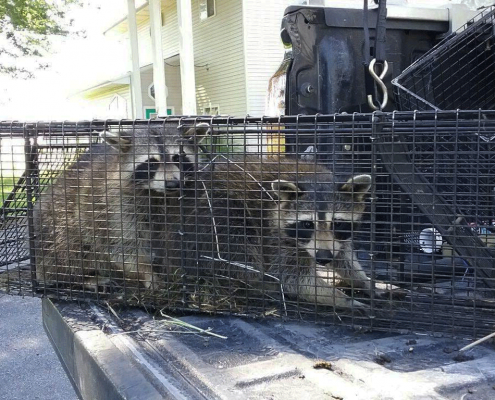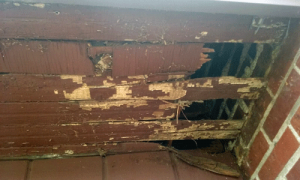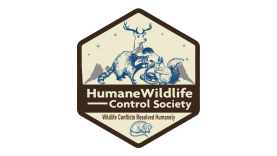
Aptly nicknamed “Trash Pandas”, raccoons are round and fuzzy animals that have bushy tails and a black mask that makes them look like bandits. They may look cute and cuddly, but they are dangerous. These cute bandits can be found almost anywhere because they eat practically anything. Awhile back, they were commonly found in forests, marshes, and anywhere close to waterways. Sometime in the 70s, these cute bandits adapted to living in urban places and were no longer afraid to come out of the forest to raid neighborhood trash cans.
Raccoon Solutions
Raccoon Description
Raccoons are medium-sized animals, close to the size of a small dog. Their body length can be as small as 16 inches (40 cm) to as big as 37 inches (95 cm). They can weigh anywhere from 11 to 57 lbs (5 to 26 kg).
The most notable feature of a raccoon is its black mask. A hypothesis for the dark mask is that it helps enhance the animal’s night vision because it reduces glare. They have grey to grayish-brown fur that insulates them against cold temperatures. They have a bushy tail that typically has five to eight alternating light and dark rings. Their hind legs are longer than their front legs, making these creatures appear hunched when walking and running. Their front paws are deft and nimble and akin to human hands, allowing them to grasp and hold anything from food to jars and latches. They also have a heightened sense of touch and their sensitivity is at its peak in their front paws. This further heightens underwater, allowing them to examine objects in water. There is also a common misconception that raccoons wash their food before they eat it. This is actually a behaviour called “dabbling”, where they dab their food in water. This is connected to their previously mentioned sensitivity in water where their sense of touch is enhanced, and it helps enable them to sort out things that are inedible from things that can be food. It also helps soften the food and helps them find foreign objects inside that might not be edible.
Raccoon tracks actually look like small handprints, with a measurement of around 2 to 3 inches across. They have five finger-like toes on both sets of feet and their tracks are asymmetrical. Their tracks are commonly seen near bodies of water, where mud preserves their tracks best. The hind feet usually sink deeper because a raccoon has a heavier hind end. Similar to a human, their innermost toe is the smallest and is further than the other toes. Their footpad is c-shaped and their hind feet usually present a larger palm and heel track. The front tracks of a raccoon measure about 1¾ - 3⅛ inches long and 1½ - 3¼ inches wide, while their rear tracks are about 2⅛ to 3⅞ inches long and 1½ - 2⅝ inches wide.
Raccoons are omnivorous and they can eat many different kinds of food. Because of the wide variety of their diet, their droppings are also diverse as well. It can vary in color, consistency, and shape. However, one thing that helps identify raccoon droppings is its location. Raccoon droppings are usually found at the base or crotches of large trees that they use for resting, or on logs and stumps near water sources. The color can range from dark to light brown, and you can often see hints of leftover seeds and berries inside them. When they are consuming drier food, their droppings can be described as circular tubes with blocky ends, a length of about 2 to 3 inches and a diameter of around ⅜ inches.
It’s also important to proceed with caution around raccoon droppings, as they are known to carry pathogens that cause diseases. One of the biggest risks from raccoons is roundworms, which can be difficult to diagnose especially if the doctor doesn’t know about past raccoon feces exposure. Symptoms of a roundworm infection include nausea, fatigue, loss of coordination, lack of attention to people and surroundings, blindness, liver enlargement, loss of muscle control, and coma. These symptoms can develop anytime between 1 to 4 weeks after feces exposure.
Raccoons are social animals that live in small communities for safety and protection. They establish community latrines, or washrooms, where they deposit their droppings repeatedly where new ones pile up on old ones. The latrines are often very big and easy to find because of the amount of raccoons in a community using them.
Raccoons have over 51 different sounds that can vary from whistles to growls and grunts. Young raccoons purr and squeak when they’re in distress, and their mothers emit an owl-like whistle-screech. Adult raccoons in distress also emit a barking sound, especially when they can’t find their young or they’re unable to escape. They can also emit a “whoop-whoop” sound and sounds of chittering, grunts, hiss, snorts, growls, snarls, screams, and whimpers, all of which vary in intensity depending on their stress levels.
These creatures are omnivores, meaning they eat both plants and meat. They are highly opportunistic eaters, and their diet heavily relies on their environment. For vegetables and plants, their diet usually includes acorns, apples, cherries, berries, peaches, plums, figs, beechnuts, walnuts, and acorns. For meat, they usually eat insects, frogs, rodents, bird eggs, and fish. It’s also shown that they consume more invertebrates than vertebrates. Raccoons are also known to scavenge for food in trash cans, and they also eat roadkill.
 Many of you may be wondering, how would I know if a raccoon ransacked my home? Or, what does a raccoon infestation even look like? Well, this article will teach you a thing or two about these little rascals that may help you determine if you’re suffering from a raccoon infestation!
Many of you may be wondering, how would I know if a raccoon ransacked my home? Or, what does a raccoon infestation even look like? Well, this article will teach you a thing or two about these little rascals that may help you determine if you’re suffering from a raccoon infestation!
The condition of the location.
When thinking about a raccoon infestation, the first thing you have to keep in mind is if raccoons even want to loiter in the area. Raccoons tend to stay in places that are dark and have a strong odor. This includes places like trash cans, dumpsters, sheds, small tight areas, and attics.
The strong smells.
Raccoons urinate and defecate as well, except unlike us humans, they don’t clean and wipe. So when you start noticing a strong stench of urine and feces, you may be looking at a raccoon infestation. Don’t think the smell is the worst part though, their waste tends to carry diseases with them too, and they can cause serious health concerns, even death.
Destruction.
Raccoons tend to force their way in especially if it’s in the way of something they want and need, and things such as food are their main driving factors. Vents, chimneys, and other easy to access places are the hotspots for raccoons to force their way in. If you notice that these places have been forcibly opened, you may be looking at an infestation! (Or a burglary from a very tiny robber).
Moving trash.
Raccoons are also known to rummage through trash cans and other places where one can find trash. So if you notice that near your house or even inside, that your trash bins have been knocked over or have had their insides rummaged through, it’s time to consider an infestation.
Thumps in the night.
Raccoons are nocturnal animals and they tend to move around at night. If you want to see if you’re suffering from a raccoon infestation, keep your ears close to your wall spaces, attics, and crawl spaces. These places are where the raccoons tend to hang out. If you hear chattering, scratching, and even whimpering, you may be looking at an infestation.
The marks.
Raccoons have very sharp claws. If you find that your house is littered with claw marks, and you know it isn’t your pet or your child scratching around the house, it may be time to start thinking that you have a raccoon infestation.
The tracks.
Raccoons are also animals that tend to move a lot, moving from one garbage can to the next, or running as soon as they perceive danger. When this happens they leave their footprints all over the place, probably because of all the dirt they’ve been stepping in. If you see little footprints and you’re sure it’s not your pet’s, then it might be time to call your nearby wildlife expert.
Raccoons are messy creatures. They topple garbage cans and leave trash all over the floor as they try to scavenge for food. Not to mention the dangerous health hazards from being exposed to their feces. We’ve all seen or heard of how much of a mess raccoons can make in a home, but how much damage can they really do?
Insulation.
This is commonly used by animals in your attic to make their nests. At 25 to 30 lbs, these creatures can easily trample and compress insulation just by walking on it. Soon your insulation will not properly function and you’ll have to cover repair bills to keep your house cool during the summer and warm during the winter. Not to mention that since these are used for nesting, you’ll soon have a little family of raccoons, screeching and moving around at night until you can’t sleep.
Wires and Ducts.
Raccoons like to chew and scratch at wires whenever they can reach them. They can also shred and strip these wires and use it for nesting material. This can cause appliances to malfunction, lights flickering, and even unnecessary repairs. This is especially
dangerous as it can also cause sparks and fires. Wire repairs, especially major ones, are also very costly. Raccoons also tend to rip apart ducts in search of nesting material, and they will completely destroy them, leaving your house without proper airflow. Insurance companies typically don’t shoulder these expenses because destruction by wildlife isn’t usually covered.
Damage to Wood.
These creatures also love to chew on wood, and there’s a lot for them to choose from in your home. As each day passes with a raccoon infestation, your house becomes more and more unsafe to live in. Most wooden beams in a house are there to keep its structural integrity, and as they chew on them, there’s a possibility that these beams can suddenly collapse. It’s very costly to repair these, and they are often unseen as they’re inside walls and above ceilings.
Damage to Pets.
Raccoons can attack your pets and other animals, especially if they sense that there is food nearby, so be careful with leaving out food for your pets. Keep an eye on very aggressive raccoons as well, as they tend to carry rabies. There are cases in rural areas where raccoons have killed chickens by decapitating them. They will then open the chicken eggs and lick out the contents. They also prey on birds and bird nests, especially if there are eggs.
Urine and Droppings.
Raccoon droppings are dangerous because they are known to carry pathogens that cause diseases, particularly roundworms. Symptoms of a roundworm infection include nausea, fatigue, loss of coordination, lack of attention to people and surroundings, blindness, liver enlargement, loss of muscle control, and coma. Raccoons usually pee and defecate in one location over and over again, releasing new ones on top of the old ones. Now, imagine all of this happening in your attic. The amount of urine and feces of one raccoon is already a serious health concern, much more a family! Aside from dealing with the infestation and repairing damages, raccoon clean-up is also a serious job and it takes time and effort to thoroughly rid your house of any trace of their droppings.
